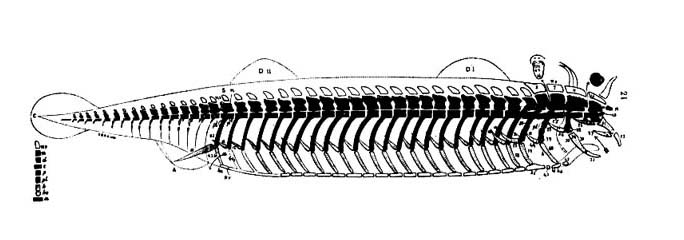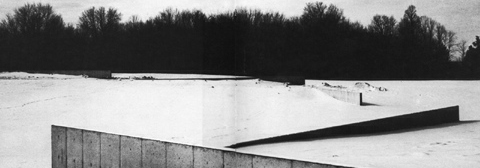A singularity is a kind of discontinuity. It might or might not be interesting. A vaguer use of the term is simply "a point where something happens" (although this equally describes an event.) Deleuze and Guattari are fascinated by singularities because they are points of unpredictability, even when deterministic. They are thus the sites of revolutionary potential.
As used by mathematical physicists, a singularity means a place where slopes become infinite, where the rate of change of one variable with another exceeds all bounds, and where a big change in an observable is caused by an arbitrarily small change in something else. (cf sensitivity to initial conditions). It is an actual point of infinite density and energy that's kind of a rupture in the fabric of space-time.
Astrophysics describe the centers of black holes as singularities.The Big Bang is considered to be a singularity.
A phase singularity is a point at which phase is ambiguous and near which phase takes on all values. Time at the poles of the earth is an example.
Read More"The question, at which point we draw the line between living and non-living is not a scientific question.The line between living and non-living at the beginning of evolution is arbitrary, just as the line between human and non-human primates at the end of evolution is arbitrary.The task of science is not to define the exact position of the line but to understand how it came to be crossed."
Read MoreIn 1892, Charles Darwin categorized human affects into seven or eight discrete expressions, each with its own facial display: happiness, sadness, fear, anger, disgust, surprise, interest, perhaps shame, and their combination. (The Expression of the Emotions in Man and Animals) According to Darwin, "The same state of mind is expressed throughout the world with remarkable uniformity." He postulated that these innate patterns of feeling and facial display evolved as social signals "understood" by all members to enhance species survival. (cf ritualization ) For Darwin, our expressions of emotion are universal (that is, innate not learned) and they are products of our evolution. They are also, at least to some extent, involuntary, and feigned emotions are rarely fully convincing.
Read MoreThe concept of homology, or morphological correspondence, was the central tenet of philosophical anatomy. It was used to define structural similarity. Homologies, which are now defined in terms of evolution, were formerly interpreted in a transcendental sense. Whereas homologous parts are now considered to have descended from a common ancestor, in the pre-Darwinian era they were usually looked upon as evidence of an ideal pattern imposed on nature, or a blueprint in the mind of the creator.
Read MoreAn Antibody is a large protein molecule which latches on to and neutralizes foreign invaders such as bacteria and viruses. Each antibody acts only on a very specific target molecule, known as an antigen. (It can also coat microbes in a way to make them palatable to scavenger cells such as microphages.)
Read MoreAutopoesis is both a concept about self-maintaining systems, especially biological ones, and an epistemological theory about cognition and self-reference.
Read MoreA bifurcation occurs when an attractor changes qualitatively with the smooth variation of a control parameter. Physically, bifurcations denote phase transitions from a state of equilibrium to new possible states of equilibria. (see also singularities)
Read MoreIn coevolutionary processes, the fitness of one organism or species depends on the characteristics of the other organisms or species with which it interacts, while all simultaneously adapt and change." At every moment natural selection is operating to change the genetic composition of populations in response to the momentary environment, but as that composition changes it forces a concommittent change in the environment itself.
Read More"Consciousness. The having of perceptions, thoughts, and feelings; awareness....When asked what consciousness is, we have no better answer than Louis Armstrong's when a reporter asked him what jazz is: "Lady, if you have to ask, you'll never know." (quoted in Pinker, How the Mind Works, p.60)
Read MoreFor Georges Bataille, (sexual)"Reproduction implies the existence of discontinuous beings." (Erotism, p.12) Each being is distinct from all others, including its parents, who are distinct from each other. For Bataille death means the continuity of being and is brought into play by reproduction. Death is the end of discontinuous being, of the being formed at the moment when the discontinuous entities of sperm and egg unite to form a new continuity, when two become one, and a new entity is formed from the fatal fusion. The fascination with both reproduction and death is the dominant element in Eroticism.
Read MoreEmergence refers to the appearance of patterns of organization and is one of the key concepts of complexity and a-life.It is sometimes referred to as a situation where the whole is greater than the sum of the parts, because it cannot be analyzed by taking the parts apart and examining them separately. One reason for this is that in a complex phenomenon showing emergent properties, the parts become a determining context for each other, and these patterns of feedback contribute to the appearance of the emergent phenomenon. For Michael Polanyi, " Evolution can be understood only as a feat of emergence."
Read MoreOne of the most important issues in the premodern biology of the 18th century was the struggle between preformationist and epigenetic theories of development. The preformationist view was that the adult organism was contained, already formed in miniature, in the sperm, and that development was the growth and solidification of this miniature being. Preformationists assumed that the germs of all living beings were preformed and had been since the Creation. Preformationism sought to maintain and secure--against the irritation posed by the complexity of organic phenomena--the claim for a thorough and rational determination of the material world.
Read MoreIn many of his essays, Steven J. Gould has suggested complications or revisions to any simple version of the Neo-Darwinian synthesis. (see, for example Wonderful Life, an graphic account of some contingencies of natural history -- as opposed to any predictable, progressive process) He has also proposed a number of alternative concepts to simple adaptation. In "The Spandrels of San Marco and the Panglossian Paradigm," ( Proceedings of the Royal Society of London , 205, 281-288) Gould and Lewontin warned against "naive adaptationism" in the explanation of traits that had emerged for other reasons. Using the dome and spandrels of the basilica of San Marco as an illustration, Gould and Lewontin showed that some traits have no specific function, but are present for reasons of architecture, development, or history. The triangular spaces of the spandrels at San Marco are simple solutions to the problem of filling in the spaces left by placing a dome on four arches. In themselves, they should not be called adaptations, as they serve no function on their own. (but they may become part of a "Bauplan.")
Read MoreThe latter part of the twentieth century is marked, above all, by the confrontation between the human and the machine, by the repeated redefinitions of each in terms of the other. In the age of biopower and biotechnologies, cyborgentities proliferate, spawning hybrid terms like artificial life, machinic phylum, virtual realities, computer agents, and desiring machines.
For the architectural avant-gardes of the earlier part of the century, this confrontation was developed and formalized through, on the one hand, the abstraction and materialilty of De Stijl and Constructivism respectively, and on the other hand, the biomorphic forms and psychic associations of Surrealism.
Read MoreThe prestige of mechanistic physics after Newton led to an extended confrontation between the norms of physics and other areas of science such as biology and psychology. Newton's Mathematical Principles of Natural Philosophystood as a classical prototype, or canon, by which to judge all subsequent science. Newton's great achievement was to have produced a mathematical theory of nature that provided general solutions based on a rational system of deduction and mathematical inference, coupled with experiment and critical observation. Newtonian mechanics established "universal laws" that explained the movements of the planets, the tides, and whose predictive powers were given an overwhelming demonstration with the appearance of Halley's comet, just as predicted, in 1758, long after both Halley and Newton were dead. Even today, the exploration of space is a straightforward application of classical gravitational mechanics.
Read More"If something is to stay in the memory, it must be burned in: only that which never ceases to hurt stays in the memory." -Friedrich Nietzsche, On the Genealogy of MoralsIs
Is memory primarily individual? Or is it social?
Individual memory can be thought as communication with the self over time. " I, entelechy, form of forms, am I by memory because under ever-changing forms." (Stephen Dedalus) "Memory is the real name of the relation to oneself, or the affect of self on self." (Deleuze, Foucault, p.107)
In Rewriting the Soul, Ian Hacking asks whether memory is the name of what once was called the soul. For Hacking, the Western moral tradition, encapsulated in the Delphic injunction to "know thyself," expresses a deeply rooted conviction that a self-knowledge is central to becoming a fully developed human being. In the modern area, this self-knowledge has increasingly focussed on issues of memory.
Individual memory can be broken into three classes:
personal memory claims concerning events in the past, which figure significantly in our self-descriptions; This is also called episodic memory
cognitive memory claims, concerning things we learned in the past; (also called semantic, or categorical memory)
habit-memory , our capacities to reproduce performances (like riding a bicycle)-- also called procedural memory.
Read More"Organic forms have a general character which distinguishes them from artificial ones.... We come then to conceive of organic form as something which is produced by the interaction of numerous forces which are balanced against one another in a near-equilibrium that has the character not of a precisely definable pattern but rather of a slightly fluid one, a rhythm...There is, in a human work of sculpture, no actual multitude of internal growth-forces which are balanced so as to issue in a near-equilibrium of a rhythmic character. We should therefore not expect that works of art will often arrive at the same type of form as we commonly find in the structures of living matter. Much more can we anticipate an influence of man's intellectualizing, pattern-making habit of simplification, diluted perhaps by an intrusion of unresolved detail." (Waddington (1951) in L.L. Whyte, ed. Aspects of Form)
Read MoreIn his book On the Origin of Species by Means of Natural Selection (1859) Darwin argued because "variations useful in some way to each being in the great and complex battle for life" do occur sometimes in thousands of generations in the wild, and because "many more individuals are born than can possible survive," then we cannot doubt that "individuals having any advantage, however slight, over others would have the best chance of surviving and of procreating their kind," while "any variations in the least degree injurious would be rigidly destroyed." It is, then, the "preservation of favourable variations and the rejection of injurious variations" that "I call Natural Selection." (from: M.J.S. Hodge, "Natural Selection: Historical Perspectives" in Keywords in Evolutionary Biology, p.212)
Read MoreFor Kant, nature is the existence of things insofar as they are determined in accordance with universal laws. For Kant, the categorial principle of unity is a requirement for the very concept of nature. As he puts it in the Prolegomena to the Critique of Pure Reason, "nature is the existence of things, considered as existence determined according to universal laws." For Kant, the idea of God serves to symbolize or "schematize" the highest form of systematic unity to which empirical knowledge can be brought, the purposive unity of things. (B714) "God has put a secret art into the forces of Nature so as to enable it to fashion itself out of chaos into a perfect world system."
Read MoreNeoteny: the neural development that certain species, notably humans, continue to experience after birth. Man is born immature and helpless. He is not capable of locomotion or of any of the directed, volitional behavior indispensable for self-preservation. The survival of the neonate is predicated on devoted parental care.
Read More



